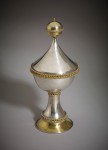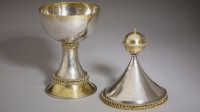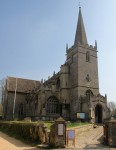 A year after St. Cyriac’s Church in the Wiltshire village of Lacock offered its prize medieval chalice for sale to the British Museum for £1.3 million ($2,130,570), the British Museum has acquired the piece it has been exhibiting on loan since 1963. The year was spent raising the money. Grants from the National Heritage Memorial Fund (£650,000) and The Art Fund (£150,000) got them 60% of the way. A large individual donation of £200,000 from investment banker and art patron John Studzinski, plus contributions from British Museum supporters, various charitable organizations and the museum’s acquisitions budget got them the rest of the way.
A year after St. Cyriac’s Church in the Wiltshire village of Lacock offered its prize medieval chalice for sale to the British Museum for £1.3 million ($2,130,570), the British Museum has acquired the piece it has been exhibiting on loan since 1963. The year was spent raising the money. Grants from the National Heritage Memorial Fund (£650,000) and The Art Fund (£150,000) got them 60% of the way. A large individual donation of £200,000 from investment banker and art patron John Studzinski, plus contributions from British Museum supporters, various charitable organizations and the museum’s acquisitions budget got them the rest of the way.
In a first that hopefully presages future such arrangements, Big Museum teamed up with the little guy on this project. The small but prestigious Wiltshire Museum in Devizes lent its aid by working on the grant applications and now it is co-owner of the Lacock Cup along with the British Museum. The original cup will mainly stay at the British Museum on permanent display in the Sir Paul and Lady Ruddock Gallery of Medieval Europe, but two identical replicas will be made by the museum’s metalworker Mike Neilson. An expert who has copied historical metal pieces from medieval chain mail to Bronze Age gold cloaks, Neilson will painstakingly recreate the chalice by hand using silver and gold. One of the replicas will go to the Wiltshire Museum where it will grace its Medieval Gallery along with other items from Lacock. The other will be given to St. Cyriac’s church so they can once again use an exquisite silver chalice for Communion on special occasions.
 Made in the early 1400s by a master silversmith, the covered chalice was not created for liturgical use. It was a secular object, a shared cup at the feast table of a rich lord. Unmissable at almost 14 inches in height and weighing more than two pounds, it was certainly meant to be seen, an indication of wealth that would stand out even on a table groaning with food and drink. Nonetheless, its ornamentation is restrained. A twisted rope design decorates the top and base of the foot and rim of the cover and a row of delicate little leaves adorn the base of the lid, the top of the stem and the base of the foot, disguising the joins that connected the bowl and two sections of the foot. The lid is topped with a spherical finial which has been gilded, as have the lip of the cup, the lower part of the foot and leaf cresting. The smooth sides and elegantly simple decoration only underscore the skill of its maker. He hand-beat the chalice from three sheets of silver; any mistake would be brutally exposed by the simplicity of the design.
Made in the early 1400s by a master silversmith, the covered chalice was not created for liturgical use. It was a secular object, a shared cup at the feast table of a rich lord. Unmissable at almost 14 inches in height and weighing more than two pounds, it was certainly meant to be seen, an indication of wealth that would stand out even on a table groaning with food and drink. Nonetheless, its ornamentation is restrained. A twisted rope design decorates the top and base of the foot and rim of the cover and a row of delicate little leaves adorn the base of the lid, the top of the stem and the base of the foot, disguising the joins that connected the bowl and two sections of the foot. The lid is topped with a spherical finial which has been gilded, as have the lip of the cup, the lower part of the foot and leaf cresting. The smooth sides and elegantly simple decoration only underscore the skill of its maker. He hand-beat the chalice from three sheets of silver; any mistake would be brutally exposed by the simplicity of the design.
There are no makers’ marks to identify the creator or any evidence of who originally owned the Lacock Cup. All we know is that some point in the 17th century (thought to be between 1621 and 1636), the chalice was given to St. Cyriac’s probably by Sir Robert Baynard of Lackham Manor. The church used it to hold Communion wine during important services like Christmas and Easter for nearly 400 years. The timing of the donation and the centuries of careful church use are what kept this extremely rare piece intact in such exquisite condition. It was one of the most common types of chalices in the Late Gothic period, but almost none of them have survived because they were melted down when the fashion changed. Had it been donated to the church before the wholesale destruction of church silver during the Reformation, it wouldn’t have survived. Instead, it was kept intact in secular hands for a couple of centuries and then kept intact in ecclesiastical hands for the next four centuries.
 Until 1981, the chalice made the return trip back to St. Cyriac’s for special occasions, but the trips stopped when its high value and perfect condition made regular travel too risky. The church, parts of which date to the 11th century and most of which dates to the early 15th century, is in desperate need of extensive repair work and, ideally, a source of funding for yearly maintenance. Since the chalice wasn’t going to be coming back any time soon due to the prohibitive cost of insurance and security, in 2009 the church explored the idea of selling it. Three years of debates ensued, ending with a legal challenge decided by an ecclesiastical consistory court in December of 2012 in favor of the sale.
Until 1981, the chalice made the return trip back to St. Cyriac’s for special occasions, but the trips stopped when its high value and perfect condition made regular travel too risky. The church, parts of which date to the 11th century and most of which dates to the early 15th century, is in desperate need of extensive repair work and, ideally, a source of funding for yearly maintenance. Since the chalice wasn’t going to be coming back any time soon due to the prohibitive cost of insurance and security, in 2009 the church explored the idea of selling it. Three years of debates ensued, ending with a legal challenge decided by an ecclesiastical consistory court in December of 2012 in favor of the sale.
Although current valuation puts the market value of the cup at around £2 million, the church offered it to the British Museum at their proposed price of £1.3 million because they wanted to ensure it stayed in its home of decades in the care of experts and accessible to the public. Now that the sale has gone through, the church plans to invest the principal and use the interest to fund necessary repairs now and in the future.
[youtube=http://youtu.be/dMv3NFJVmBE&w=430]